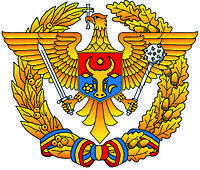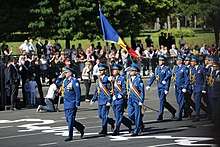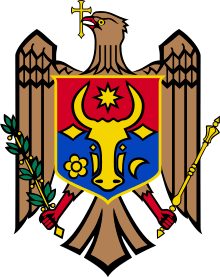Armed Forces of the Republic of Moldova
| Armed Forces of the Republic of Moldova | |
|---|---|
|
Forțele Armate ale Republicii Moldova (Romanian) Форцеле Армате але Републичи Молдова | |
 | |
| Service branches |
Moldovan Ground Forces Moldovan Air Force |
| Leadership | |
| Supreme Commander | Igor Dodon |
| Minister of Defence | Eugen Sturza |
| Chief of the General Staff | Brigader General Igor Cutie |
| Manpower | |
| Military age | 18 |
| Available for military service | 1,066,459, age 18–49 (2005 est.) |
| Fit for military service | 693,913, age 18–49 (2005 est.) |
| Reaching military age annually | 43,729 (2005 est.) |
| Active personnel | 5,000-7,500 (2018) |
| Reserve personnel | 65,000-70,000 (2018) |
| Expenditures | |
| Budget | $28.4 million (2017) |
| Percent of GDP | 1.4% |
| Industry | |
| Foreign suppliers |
|
| Related articles | |
| Ranks | Ranks of the Armed Forces of Moldova |
The Armed Forces of the Republic of Moldova (Romanian: Forțele Armate ale Republicii Moldova), also known as the Moldovan National Army consist of the Ground Forces and Air and Air Defense Force.
History



On 2 November 1990, prior to the formation of the state of Moldova, the Supreme Soviet of the Moldovan SSR ordered creation of the Republican Guard (Moldovan: Garda Republicană) as a militarized government agency. This force subsequently became the Moldovan military upon independence.[1][2][3]
Moldova has accepted all relevant arms control obligations of the former Soviet Union. On October 30, 1992, Moldova ratified the Treaty on Conventional Armed Forces in Europe, which establishes comprehensive limits on key categories of conventional military equipment and provides for the destruction of weapons in excess of those limits. It acceded to the provisions of the nuclear Non-Proliferation Treaty in October 1994 in Washington, DC. It does not have nuclear, biological, or chemical weapons.
Moldova joined the North Atlantic Treaty Organisation's Partnership for Peace on March 16, 1994.
A transition to a professional force of 12,000 to 15,000 volunteers was planned at first, but when fighting erupted in 1991 between supporters of the central government in Chișinău and supporters of separatist regions, males between eighteen and forty years of age were mobilized, and the size of Moldova's military was temporarily expanded to meet the demands of the Transnistrian conflict.[4] In early 1995, the armed forces totaled some 11,000 volunteers, and there were plans to gradually create a professional army, similar to that of the United States.
General Staff
The General Staff of the National Army is currently composed of the following:
- Headquarters of the General Staff (Chisinau)
- Land Force Command
- Air Force Command
- Personnel Directorate
- Operations Directorate
- Logistics Directorate
- Strategic Planning Directorate
- Communication and Information Systems Directorate
- Education, Training and Doctrine Directorate
- Planning, Finance and Monitoring
- Legal Section
- Medical Section
Land forces
At the beginning of 1994, the Moldovan Ground Forces (under the Ministry of Defense) consisted of 9,800 men organized into three motor rifle brigades, one artillery brigade, and one reconnaissance/assault battalion.[4] The Library of Congress Country Studies wrote that its armaments consisted of fifty-six ballistic missile defenses; seventy-seven armored personnel carriers and sixty-seven "look-alikes." ("Look-alikes" is a Conventional Forces in Europe Treaty term denoting modifications of armored personnel carriers for specialised missions such as anti-tank missile carriage, reconnaissance, or engineer duties). This data appears garbled; in the 1995/96 edition of the IISS Military Balance, armored infantry fighting vehicles were listed as 54 BMDs (Boyevaya Mashina Desanta, Airborne Combat Vehicle), there were sundry armored personnel carriers, and 67 "look-alikes".[5]
Artillery included eighteen 122 mm and fifty-three 152 mm towed artillery units; nine 120 mm combined guns/mortars; seventy AT-4 Spigot, nineteen AT-5 Spandrel, and twenty-seven AT-6 Spiral anti-tank guided weapons; one hundred thirty-eight 73 mm SPG-9 recoilless launcher, forty-five MT-12 100 mm anti-tank guns; and thirty ZU-23 23 mm and twelve S-60 57 mm air defense guns. Moldova has received some arms from former Soviet stocks maintained on the territory of the republic as well as undetermined quantities of arms from Romania, particularly at the height of the fighting with Transnistria.
By 2006-7, the Moldovan Ground Forces had been reduced to a strength of 5,710, including three motor rifle brigades, one artillery brigade, and independent Special forces and engineer battalions, plus an independent guard unit. Equipment and weaponry included 44 BMD-1 AIFVs, and 266 APCs, including 91 TAB-71s, as well as 227 artillery pieces.[6]
Air Force

In 1994 the Moldovan Air Force consisted of 1,300 men organized into one fighter regiment, one helicopter squadron, and one missile brigade.[4] Armaments used by the air force included thirty-one MiG-29 Fulcrum aircraft, eight Mi-8 Hip helicopters, five transport aircraft (including an Antonov An-72 Coaler), and twenty-five SA-3 Goa/SA-5 Gammon surface-to-air missiles.
The 86th Guards Fighter Aviation Regiment had been located at Mărculești since October 1951, and had been reequipped with MiG-29s in 1988.[7] It had been part of the 119th Fighter Aviation Division, which had been resubordinated to the Soviet Black Sea Fleet since December 1989.
Twenty-one of the MiG-29s were sold to the United States in October 1997 to prevent their sale on the world market, and for research purposes. All the spare parts for those aircraft were also purchased, as were the accompanying 500 air-to-air missiles. [8] All the aircraft were transported from Moldova to the National Air Intelligence Center (NAIC) at Wright-Patterson Air Force Base near Dayton, Ohio in Boeing C-17 Globemaster III transport planes over a period of two weeks.[9]
As of 2006 all the MiG-29 fighters had either been sold or scrapped, and the Moldovan Air Force had only 2 An-2 Colts, 1 An-26 Curl, 2 An-72 Coalers, 8 Mi-8 Hips, and 12 SA-3 'Goa' SAMs in service, manned by 1,040 personnel.[6]
Foreign forces
Other military forces also existed within Moldova. In early 1994, the government of the "Dnestr Republic" had armed forces of about 5,000 which included the Dnestr battalion of the Republic Guard and some 1,000 cossacks.[4]
As of early 1994, the former Soviet 14th Guards Army (about 9,200 troops) consisted of one army headquarters, the 59th Guards Motor Rifle Division, one tank battalion, one artillery regiment, and one anti-aircraft brigade. Their equipment and weaponry consisted of 120 main battle tanks, 180 armoured fighting vehicles, and 130 artillery pieces/multiple rocket launchers/mortars. The remainder of the 14th Guards Army had been over the border in Ukraine and was absorbed by the Ukrainian armed forces.
Around 1994, peacekeepers in Transnistria consisted of six airborne battalions supplied by Russia, three infantry battalions supplied by Moldova, and three airborne battalions supplied by the "Dnestr Republic."[4]
Since 2007 the Russian force, now designated the Operational Group of Russian Forces in Moldova, under the command of the Western Military District had withered away to a strength of some 1500 which included two motor rifle battalions, an independent security and support battalion, a helicopter detachment and several smaller, administrative detachments.
See also
References
| Wikimedia Commons has media related to Army of Moldova. |
- ↑ Dailey, Erika; Laber, Jeri; Whitman, Lois (1993). Human Rights in Moldova: The Turbulent Dniester. Human Rights Watch. ISBN 9781564320896.
- ↑ "6. Anularea Hotărîrii Sovietului Suprem al R.S.S. Moldova din 2 noiembrie 1990 "Cu privire la Garda republicană a Moldovei"".
- ↑ Александрович, Жирохов Михаил (2012). Семена распада: войны и конфликты на территории бывшего СССР (in Russian). БХВ-Петербург. ISBN 9785977508179.
- 1 2 3 4 5 Library of Congress Country Studies: Moldova, The Armed Forces, June 1995
- ↑ IISS Military Balance 1995/96, p.91
- 1 2 Routledge/IISS, IISS Military Balance 2007, p.170
- ↑ Michael Holm, 86th Guards Fighter Aviation Regiment, accessed September 2011
- ↑ Arms Control Association: Arms Control Today: U.S. Buys Moldovan Aircraft to Prevent Acquisition by Iran
- ↑ DefenseLink News Transcript, DoD News Briefing: Cooperative Threat Reduction Initiative
